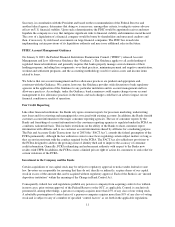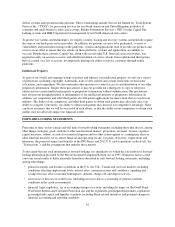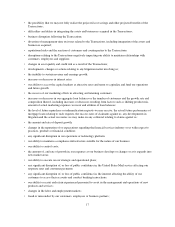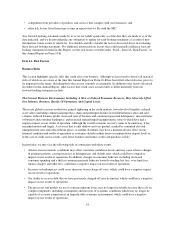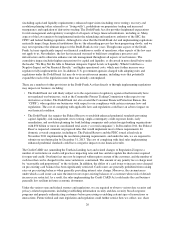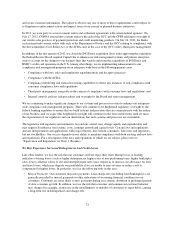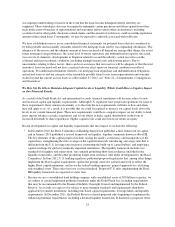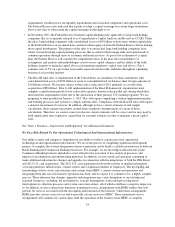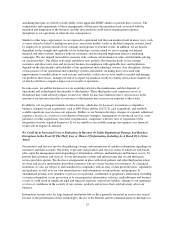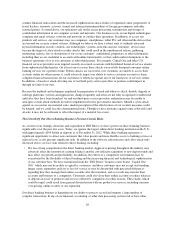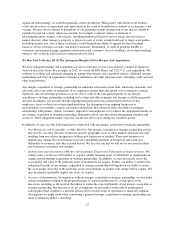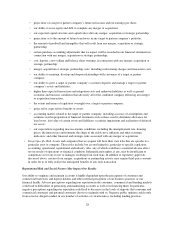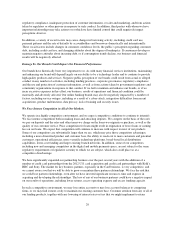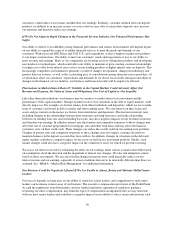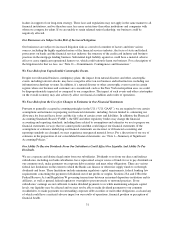Capital One 2012 Annual Report Download - page 40
Download and view the complete annual report
Please find page 40 of the 2012 Capital One annual report below. You can navigate through the pages in the report by either clicking on the pages listed below, or by using the keyword search tool below to find specific information within the annual report.and secure customer information. The failure to observe any one or more of these requirements could subject us
to litigation or enforcement actions and impact some of our current or planned business initiatives.
In 2012, we were party to several consent orders and settlement agreements with certain federal agencies. On
July 17, 2012, COBNA entered into consent orders with each of the OCC and the CFPB relating to oversight of
our vendor sales practices of payment protection and credit monitoring products. On July 26, 2012, the Banks
each entered into consent orders with each of the Department of Justice and the OCC relating to compliance with
the Servicemembers Civil Relief Act, or the SCRA, and, in the case of the OCC orders, third-party management.
In addition, in the first quarter of 2012, we closed the ING Direct acquisition. In its order approving the acquisition,
the Federal Reserve Board required Capital One to enhance our risk-management systems and policies enterprise-
wide to account for the changes to our business lines that would result from the acquisitions of ING Direct and
HSBC’s credit card operations in the U.S. Among other things, we are implementing enhancements to our
compliance risk management programs on an enterprise-wide basis in the following primary areas:
• Compliance with laws, rules and regulations regarding unfair and deceptive practices;
• Compliance with the SCRA;
• Compliance monitoring and transaction testing capabilities to detect any instances of non-compliance with
consumer compliance laws and regulations;
• Third-party management, especially in the context of compliance with consumer laws and regulations; and
• Internal controls, policies and procedures and oversight by the Board and senior management.
We are continuing to make significant changes to our systems and processes in order to enhance our enterprise-
wide compliance risk management programs. There will continue to be heightened regulatory oversight by the
federal banking regulators to ensure that we build systems and processes that are commensurate with the nature
of our business, and we expect this heightened oversight will continue for the foreseeable future until we meet
the expectations of our regulators and can demonstrate that such systems and processes are sustainable.
The legislative and regulatory environment is beyond our control, may change rapidly and unpredictably and
may negatively influence our revenue, costs, earnings, growth and capital levels. Certain laws and regulations,
and any interpretations and applications with respect thereto, may benefit consumers, borrowers and depositors,
but not stockholders. Our success depends on our ability to maintain compliance with both existing and new laws
and regulations. For a description of the laws and regulations to which we are subject, please refer to
“Supervision and Regulation” in “Item 1. Business.”
We May Experience Increased Delinquencies And Credit Losses.
Like other lenders, we face the risk that our customers will not repay their loans. Rising losses or leading
indicators of rising losses (such as higher delinquencies, higher rates of non-performing loans, higher bankruptcy
rates, lower collateral values or elevated unemployment rates) may require us to increase our allowance for loan
and lease losses, which may degrade our profitability if we are unable to raise revenue or reduce costs to
compensate for higher losses. In particular, we face the following risks in this area:
•Missed Payments. Our customers may miss payments. Loan charge-offs (including from bankruptcies) are
generally preceded by missed payments or other indications of worsening financial condition for our
customers. Customers are more likely to miss payments during an economic downturn or prolonged periods
of slow economic growth. In addition, we face the risk that consumer and commercial customer behavior
may change (for example, an increase in the unwillingness or inability of customers to repay debt), causing
a long-term rise in delinquencies and charge-offs.
21


